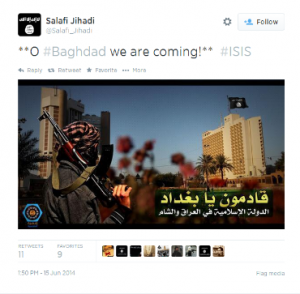
Islamic State Hashtag Diplomacy
In tandem with its acquisition of physical territory in the Middle East, the Islamic State terrorist organization has been choreographing a parallel insurgence on social media. As J.M. Berger wrote in The Atlantic, “The advance of an army used to be marked by war drums. Now it’s marked by volleys of tweets.”
The Islamic State has taken a multifaceted approach to social media, saturating sharing sites like Twitter and Facebook from multiple angles including the official IS account, regional IS accounts, and the accounts of individual mujahedeen fighters and radical supporters. The official and regional accounts have been used primarily to promote the organization through multimedia propaganda. On the other hand, the individual fighter accounts are treated much like regular twitter accounts, documenting the ordinary, relatable aspects of their daily life. However, recruitment messages and violent propaganda are systematically incorporated as well, creating a duality between fear and credibility intended to frighten enemies while appealing to potential followers. Finally, in the organization’s most recent tech-savvy maneuver, the Islamic State released the Android app “The Dawn of Glad Tidings” in April, through which users can subscribe to IS news updates while simultaneously authorizing the organization to automatically tweet from their personal accounts. While the Islamic State is certainly not the first terrorist organization to utilize social media, they are proving to be much more effective at it than most.
In fact, social media and internet tools favor non-state actors, and subsequently extremist organizations, while restricting the power of more dominant state actors. This is because governments are self-restricted in creating the types of sensationalist or attention-grabbing material that tends to go viral online. This new realm of asymmetrical information warfare grants influence to organizations like the Islamic State who would struggle with conventional methods of communication such as newspapers or television. Yet on social media, a government’s slowly-generated, moderated messages can often be drowned out by the extremist, eye-catching propaganda of organizations like the Islamic State.
 Although it is clear that the Islamic State’s approach to social media is overinflating the organization’s actual outreach and following, it appears that their intent may be to use this inflated stature to their advantage. Over-projecting their current following creates an artificial bandwagon that could entice potential supporters who are currently on the fence. Also, by appearing larger and thus more intimidating while backing up their tweets with real-world action, their messages are treated more seriously. For example, the Dawn app reached almost 40,000 tweets the day the Islamic State marched on Mosul. By the time IS forces arrived, many Iraqi soldiers had already fled the city in fear, allowing the Islamic State to take over an entire city with relatively little armed conflict. Then, by live-tweeting their successful insurgence, IS grants themselves credibility for future threats.
Although it is clear that the Islamic State’s approach to social media is overinflating the organization’s actual outreach and following, it appears that their intent may be to use this inflated stature to their advantage. Over-projecting their current following creates an artificial bandwagon that could entice potential supporters who are currently on the fence. Also, by appearing larger and thus more intimidating while backing up their tweets with real-world action, their messages are treated more seriously. For example, the Dawn app reached almost 40,000 tweets the day the Islamic State marched on Mosul. By the time IS forces arrived, many Iraqi soldiers had already fled the city in fear, allowing the Islamic State to take over an entire city with relatively little armed conflict. Then, by live-tweeting their successful insurgence, IS grants themselves credibility for future threats.
Through these clever social media techniques, the IS leadership has been able to manufacture a campaign that resembles a grass-roots movement. Although the Iraqi government recently censored social media within its borders, the Islamic State is having no trouble circumventing these restrictions. Twitter has also removed several accounts connected with the IS organization for violating the site’s protocol, but these attempts to stamp out the Islamic State’s social media presence have been futile. For each account removed, three more can appear in its place, generating a never-ending game of virtual whack-a-mole.






[…] Lately, the Think Again campaign has been primarily addressing the Islamic State, which has been particularly active in the online […]